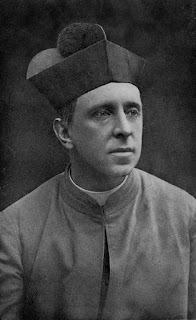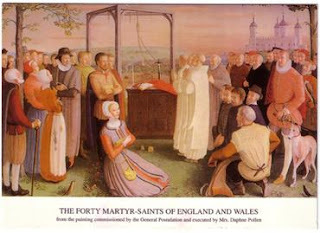Preview: 120th Anniversary of R.H. Benson's "The King's Achievement"
 The King's Achievement
, Monsignor Robert Hugh Benson's historical novel about the Dissolution of the Monasteries, was published in 1905, 120 years ago. It was one of those books I read years before I started studying the English Reformation in depth before writing my book, so I've selected it for our next Son Rise Morning Show 2025 anniversary on Monday, October 13, Columbus Day! I'll be on the air at my usual time, 7:50 a.m. Eastern/6:50 a.m. Central to discuss this anniversary and its importance. Please listen live here or catch the podcast later here.
The King's Achievement
, Monsignor Robert Hugh Benson's historical novel about the Dissolution of the Monasteries, was published in 1905, 120 years ago. It was one of those books I read years before I started studying the English Reformation in depth before writing my book, so I've selected it for our next Son Rise Morning Show 2025 anniversary on Monday, October 13, Columbus Day! I'll be on the air at my usual time, 7:50 a.m. Eastern/6:50 a.m. Central to discuss this anniversary and its importance. Please listen live here or catch the podcast later here.Like its sequel, By What Authority? , which was published in 1904, The King's Achievement is a family drama, as Benson shows the divisions caused in two families by the English Reformation during the reigns of Henry VIII and Elizabeth I. One link between the two novels, for example, is the former nun, Margaret Torridon, taken from her convent by her own brother in The King's Achievement, living years later in the Catholic household of her brother-in-law and sister Mary in By What Authority?
Monsignor Robert Hugh Benson was a convert to Catholicism, the youngest son of Edward White Benson, the Archbishop of Canterbury from 1883 to 1896, and his wife, Mary. Robert's older brothers, E.F. (Edward Frederick) and A.C. (Arthur Christopher) were also authors: E.F. wrote the "Mapp and Lucia" novels and A.C. contributed to Elgar's Coronation Ode written for Edward VII in 1902 and "Land of Hope and Glory"; he was also Master of Magdalene College, Cambridge. Their sister Margaret was an Egyptologist.
After his conversion to Catholicism in 1903, Robert Hugh Benson was ordained a priest the next year.
He wrote several novels, historical and contemporary, and consulted with Don Bede Camm, another Catholic convert, who studied the English Reformation martyrs, on his historical novels. He acknowledges Dom Bede Camm's assistance in both By What Authority? and The King's Achievement.
Dom Bede Camm was inspired by the stories of the English Catholic martyrs beatified by Pope Leo XIII and published a two-volume book about them in 1904, Lives of the English Martyrs. He also helped the Benedictine Adorers of the Sacred Heart of Montmartre who had established a convent near the former site of Tyburn Tree, where many martyrs suffered.
So Camm was a good resource for Benson, but the characters and the dramas Benson created are fictional--although Thomas More, Thomas Cromwell, and other historical people appear in The King's Achievement.
Ralph, the elder son of the Torridon family, works for Thomas Cromwell and he goes to visit More at his Chelsea home in Chapter V, "Master More":
It was a wonderfully pleasant house, Ralph thought, as his wherry came up to the foot of the garden stairs that led down from the lawn to the river. It stood well back in its own grounds, divided from the river by a wall with a wicket gate in it. There was a little grove of trees on either side of it ; a flock of pigeons were wheeling about the bell-turret 'that rose into the clear blue sky, and from which came a stroke or two, announcing the approach of dinner-time as he went up the steps.
There was a figure lying on its face in the shadow by the house, as Ralph came up the path, and a small dog, that seemed to be trying to dig the head out from the hands in which it was buried, ceased his excavations and set up a shrill barking. The figure rolled over, and sat up ; the pleasant brown face was all creased with laughter ; small pieces of grass were clinging to the long hair, and Ralph, to his amazement, recognised the ex- Lord Chancellor of England.
In the plot of The King's Achievement, the crucial issue is Ralph's corruption and cruelty as he does Cromwell's will, closing the monasteries and nunneries, leaving the practice of his family's Catholic faith, and even preparing to betray even his master Cromwell when his fall comes, after having betrayed Thomas More by pretending to help him. Beatrice, a young lady from More's household, loves Ralph and trusts him until he demonstrates his cruelty to More and his own family.
It's an old fashioned novel, but Benson demonstrates great insight into Ralph's character, as he continues to serve Cromwell as he believes he is serving Henry VIII, betraying his own father, his brother Chris a monk at Lewes, and his sisters. There are some dramatic scenes of family conflict and estrangement, especially in the chapters "Father and Son" and "A Nun's Defiance", when Ralph "visits" his sister Margaret's convent to cast her out because she is underage. Benson depicts the corruption of Cromwell's visitors of the monasteries and the convents, and even as Ralph sees it himself, he accepts it as part of his duty to his master and his king.
The twist of the novel is that the great concern of Beatrice and Chris is the redemption of the souls of Ralph and his mother, who also become cold and skeptical toward both family and Church. Beatrice and Chris work together to reconcile both of them in spite of all the suffering they've endured.

The significance of this book is that, while Dom Bede Camm was studying the English martyrs and writing individual stories about their sufferings, and at the same time helping the Benedictine Adorers of the Sacred Heart of Montmartre establish their monastery shrine near Tyburn, Monsignor Benson was offering this historical novel.
Thus he could show what these divisions, disruptions, and sufferings meant to families, to the relationships between husband and wife, father and son, sister and brother, brother and brother, and even a man and a woman who were beginning to love each other perhaps toward being married. As dramatic as the martyrdoms of Thomas More, the three Carthusians, and Bishop John Fisher were--and Benson does not neglect them--readers can sympathize and even empathize with what the families suffered.
That's what fiction or drama can do. And Benson does it very well.



